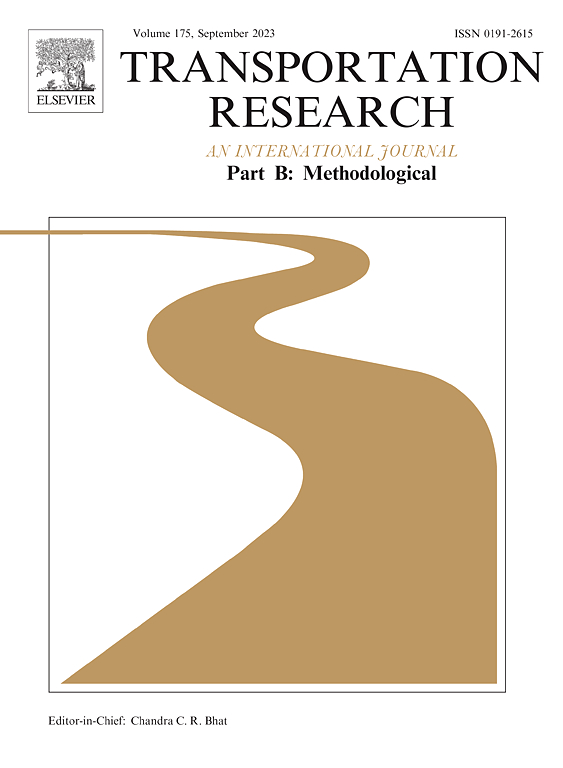A bi-level optimization model for project scheduling and traffic flow routing in railway networks
IF 6.3
1区 工程技术
Q1 ECONOMICS
引用次数: 0
Abstract
Long-term tactical infrastructure planning for a transportation network consists of deciding on renewals and major maintenance works. Such projects constitute large budget volumes and will impair the available traffic capacity during their execution, especially for railway systems. Quantitative methods that schedule and coordinate infrastructure projects together with traffic flow adaptations is however largely lacking today.
This paper addresses the joint planning of temporary capacity restrictions and traffic flow adaptions during track work closures, by proposing a bi-level optimization model which separates the problem into project scheduling (upper level) and traffic assignment (lower level). The latter model uses a novel traffic flow formulation for routing volumes of trains through the transportation network under the capacity restrictions given by the project scheduling. An aggregated network is used together with time discretized into uniform periods, which makes it possible to treat large national planning problems with a planning horizon of up to a year and a period length of a couple hours. The computational properties are evaluated, both for the individual models, and for their joint usage. Furthermore, results from applying the models on two case studies, concerning Northern and South-Western Sweden, are presented.
The main conclusion is that the model formulations are capable of solving realistic planning cases and to provide support for capacity planners at an infrastructure manager, even for a large national railway. The results show that a good overview over the collective traffic impact is obtained, but also that details of particular traffic relations or capacity usage over individual network links and their variation over time can be studied. One major deficiency has been identified in the flow-based traffic assignment model, which can lead to incoherent train flows over long traveling distances and many time periods.
铁路网络项目调度与交通流路径的双层优化模型
交通网络的长期战术基础设施规划包括决定更新和主要维护工程。这些项目的预算数额很大,在执行过程中会损害现有的交通能力,特别是铁路系统。然而,目前在很大程度上缺乏计划和协调基础设施项目以及交通流量调整的定量方法。本文提出了一种双层优化模型,将问题分为项目调度(上层)和交通分配(下层),解决了轨道工程关闭期间临时通行能力限制和交通流量适应的联合规划问题。后一种模型采用一种新颖的交通流公式,在项目调度给出的容量限制下,对通过交通网络的列车量进行路由。一个综合的网络连同离散成统一时期的时间一起使用,这使得有可能以长达一年的规划范围和几个小时的时间长度来处理大型国家规划问题。计算性质进行了评估,既为单独的模型,并为他们的联合使用。此外,还介绍了将模型应用于瑞典北部和西南部的两个案例研究的结果。主要结论是,模型公式能够解决现实的规划案例,并为基础设施管理人员的能力规划人员提供支持,即使是大型国家铁路。结果表明,可以很好地概述总体流量影响,还可以研究特定流量关系或单个网络链路上的容量使用及其随时间变化的详细信息。在基于流量的交通分配模型中,一个主要的缺陷已经被发现,它可能导致在长距离和许多时间段内不连贯的列车流。
本文章由计算机程序翻译,如有差异,请以英文原文为准。
求助全文
约1分钟内获得全文
求助全文
来源期刊
CiteScore
12.40
自引率
8.80%
发文量
143
审稿时长
14.1 weeks
期刊介绍:
Transportation Research: Part B publishes papers on all methodological aspects of the subject, particularly those that require mathematical analysis. The general theme of the journal is the development and solution of problems that are adequately motivated to deal with important aspects of the design and/or analysis of transportation systems. Areas covered include: traffic flow; design and analysis of transportation networks; control and scheduling; optimization; queuing theory; logistics; supply chains; development and application of statistical, econometric and mathematical models to address transportation problems; cost models; pricing and/or investment; traveler or shipper behavior; cost-benefit methodologies.

 求助内容:
求助内容: 应助结果提醒方式:
应助结果提醒方式:


